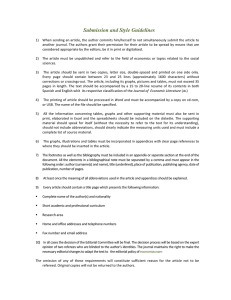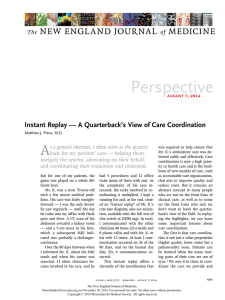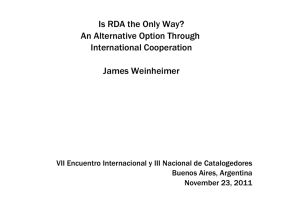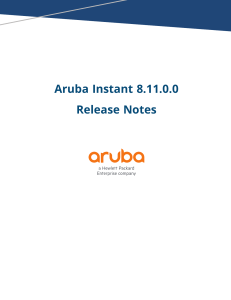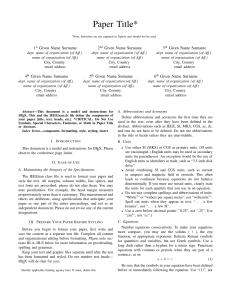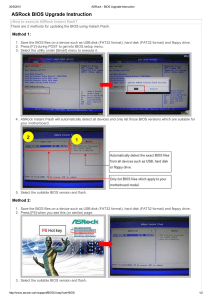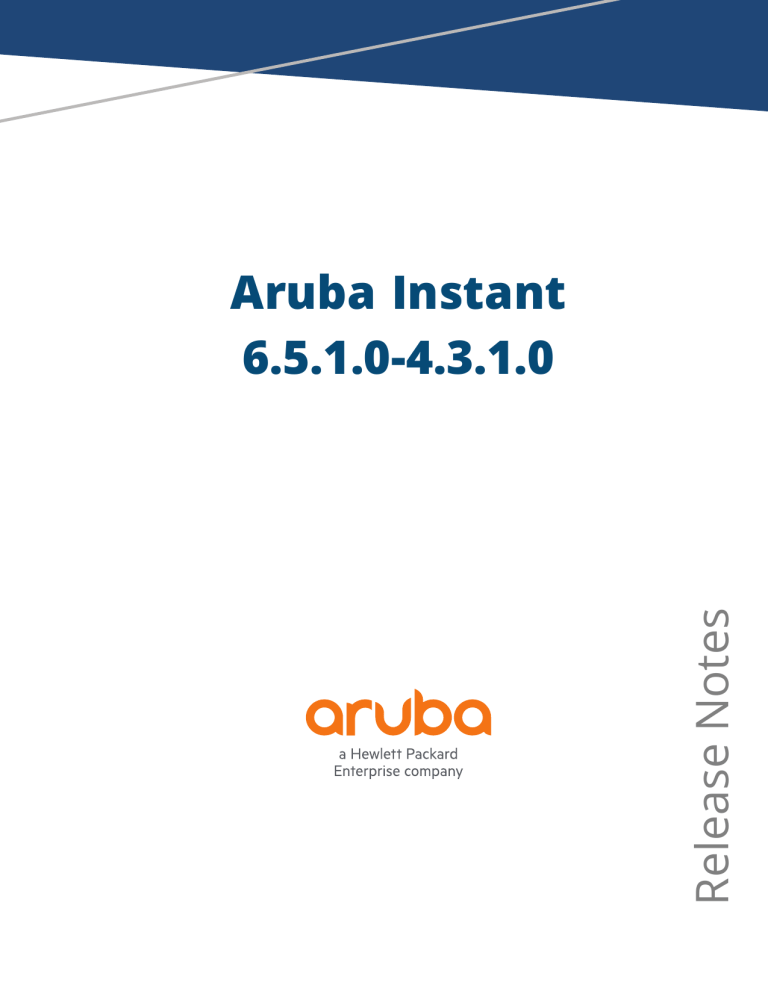
Release Notes Aruba Instant 6.5.1.0-4.3.1.0 Copyright © Copyright 2018 Hewlett Packard Enterprise Development LP. Open Source Code This product includes code licensed under the GNU General Public License, the GNU Lesser General Public License, and/or certain other open source licenses. A complete machine-readable copy of the source code corresponding to such code is available upon request. This offer is valid to anyone in receipt of this information and shall expire three years following the date of the final distribution of this product version by Hewlett Packard Enterprise Company. To obtain such source code, send a check or money order in the amount of US $10.00 to: Hewlett Packard Enterprise Company Attn: General Counsel 3000 Hanover Street Palo Alto, CA 94304 USA Revision 02 | January 2018 Aruba Instant 6.5.1.0-4.3.1.0 | Release Notes Contents Contents Revision History Release Overview 3 4 5 Contents 5 Contacting Support 5 What's New in this Release 6 Important Updates 6 Regulatory Domain Updates 6 New Features and Enhancements 7 Resolved Issues in this Release 9 Known Issues 12 Known Issues 12 Acronyms and Abbreviations Aruba Instant 6.5.1.0-4.3.1.0 | Release Notes 13 Contents | 3 Revision History The following table provides the revision history of this document. Table 1: Revision History Revision Change Description Revision 02 Added information about IAP-103 upgrade. Revision 01 Initial release. Revision 02 | January 2018 Aruba Instant 6.5.1.0-4.3.1.0 | Release Notes Chapter 1 Release Overview Aruba Instant 6.5.1.0-4.3.1.0 is a major software release that introduces new features and enhancements. For information on upgrading IAPs to the new release version, refer to the Upgrading an IAP topic in the Aruba Instant 6.5.1.0-4.3.1.0 User Guide. Contents What's New in this Release on page 6 lists the regulatory information, new features and enhancements, and fixed issues in Aruba Instant 6.5.1.0-4.3.1.0 release. Known Issues on page 12 lists the known issues and limitations identified in the Aruba Instant 6.5.1.0-4.3.1.0 release. Contacting Support Main Site arubanetworks.com Support Site support.arubanetworks.com Airheads Social Forums and Knowledge Base community.arubanetworks.com North American Telephone 1-800-943-4526 (Toll Free) 1-408-754-1200 International Telephone arubanetworks.com/support-services/contact-support/ Software Licensing Site licensing.arubanetworks.com End-of-life Information arubanetworks.com/support-services/end-of-life/ Security Incident Response Team (SIRT) Site: arubanetworks.com/support-services/security-bulletins/ Email: [email protected] Aruba Instant 6.5.1.0-4.3.1.0 | Release Notes Release Overview | 5 Chapter 2 What's New in this Release This chapter lists the regulatory information, features, enhancements, fixed issues, known issues and limitations in the Aruba Instant 6.5.1.0-4.3.1.0 release. Important Updates End of Support for Legacy 802.11n Instant Access Points Starting from Instant 6.5.0.0-4.3.0.0, the following 802.11n IAPs are not supported: n IAP-104 and IAP-105 n RAP-3WN and RAP-3WNP n IAP-134 and IAP-135 n IAP-175 Updates for Instant 6.5.1.0-4.3.1.0 n The Application and Application Category features for AppRF is temporarily disabled for IAP-205/205H platforms in the Instant 6.5.1.0-4.3.1.0 release. However, the Web Category feature is still supported. n Cluster Security with DTLS is a beta feature. Currently 16 IAPs and 256 clients are supported in an IAP cluster when this feature is enabled. n IAP-205H does not have BLE support. n Do not upgrade the IAP-103 access points to this release version when DPI is enabled. They reboot because of low memory. Regulatory Domain Updates The following table lists the DRT file versions supported by Instant 6.5.1.0-4.3.1.0 release: Table 2: DRT Versions Instant Release Version Applicable DRT Version 6.5.1.0-4.3.1.0 1.0_57440 For a complete list of countries certified with different AP models, see the respective DRT release notes at support.arubanetworks.com. Aruba Instant 6.5.1.0-4.3.1.0 | Release Notes What's New in this Release | 6 New Features and Enhancements The following new features and enhancements are introduced in this release: Support for New IAP Devices IAP-300 Series The IAP-300 Series (IAP-304/305) wireless access points are equipped with one 10/100/1000Base-T autosensing MDI/MDX Ethernet port. This port supports wired-network connectivity, in addition to Power over Ethernet (PoE) from IEEE 802.3af and 802.3at compliant power sources. They also have two LEDs that indicate the system and radio status of the device and are equipped with three external antenna connectors. IAP-207 The IAP-207 access points are equipped with one 10/100/1000Base-T (RJ-45) auto-sensing, MDI/MDX Ethernet port ENET0) for wired network connectivity. This port supports IEEE 802.3af Power over Ethernet (PoE), as a standard defined Powered Device (PD) from a Power Sourcing Equipment (PSE) such as a PoE midspan injector or network infrastructure that supports PoE. The 207 Series access points have two LEDs that indicate the system and radio status of the device. Support for Cluster Security Instant 6.5.1.0-4.3.1.0 introduces support for cluster security on IAPs to secure the control plane communication between IAPs in a cluster. Additionally, DTLS is used with cluster security for extended security facilities. Cluster security also provides the option of logging and debugging by organizing the logs into modules which are later used for debugging. For more information, see: n Cluster Security in Aruba Instant 6.5.1.0-4.3.1.0 User Guide. n cluster-security, cluster-security logging, show cluster-security, and show log papi-handler commands in the Aruba Instant 6.5.1.0-4.3.1.0 CLI Reference Guide. Support for RFC5997 Starting from Instant 6.5.1.0-4.3.1.0, you can configure the RFC5997 feature on the IAP to send a status request query to the RADIUS server each time there is an authentication or accounting request timeout. This helps determine if the server is actually down before marking the server as unavailable. For more information, see: n Configuring an External Server for Authentication in Aruba Instant 6.5.1.0-4.3.1.0 User Guide. n wlan auth-server in Aruba Instant 6.5.1.0-4.3.1.0 CLI Reference Guide. Clarity Live Instant now supports inline monitoring through Clarity Live to identify client connectivity issues and send the data to AirWave for analysis. It helps in isolating the root cause of the connectivity issues experienced by receiving regular statistics and updates generated by the events. For more information, see: n Clarity Live in Aruba Instant 6.5.1.0-4.3.1.0 User Guide. n clarity, show clarity config, and show clarity history in Aruba Instant 6.5.1.0-4.3.1.0 CLI Reference Guide. Revision 02 | January 2018 Aruba Instant 6.5.1.0-4.3.1.0 | Release Notes Client Match for Access Points in a Zone Starting from Instant 6.5.1.0-4.3.1.0, the decision to move a client from a home IAP to a target IAP will be made at the SSID level instead of the radio level, by adding the SSID name to the client match radio database. Client Match will check if the same SSID (zone specific SSID on Home IAP) is available on the target IAP before it moves the client. For more information, see: n Client Match for Access Points in a Zone in Aruba Instant 6.5.1.0-4.3.1.0 User Guide. n show ap client-match-ssid-table and show ap client-match-ssid-table radio-mac <mac> commands in Aruba Instant 6.5.1.0-4.3.1.0 CLI Reference Guide. Changing the Installation Mode Instant now allows users to change the installation type of the IAPs from indoor to outdoor or vice-versa. For more information, see: n Changing the IAP Installation Mode in Aruba Instant 6.5.1.0-4.3.1.0 User Guide. n ap-installation command in Aruba Instant 6.5.1.0-4.3.1.0 CLI Reference Guide. Support for Mesh in IAP-31x and IAP-32x Access Points Starting from Instant 6.5.1.0-4.3.1.0, support for Mesh is introduced in IAP-31x and IAP-32x access points. Enhancement to VPN Monitoring in AirWave Starting from Instant 6.5.1.0-4.3.1.0, AMP receives a notification from the IAP every time the status of the VPN tunnel changes between UP and Down. For more information, see the AirWave 8.2.3.1 User Guide. Revision 02 | January 2018 Aruba Instant 6.5.1.0-4.3.1.0 | Release Notes Resolved Issues in this Release The following issues are fixed in the Instant 6.5.1.0-4.3.1.0 release. AppRF Table 3: AppRF Fixed Issue Bug ID Description 147333 Symptom: Clients were able to download files through different torrent clients even though the App category deny ACL is configured on the SSIDs. The fix ensures that the torrent clients are inaccessible when the App deny ACLs are configured on the SSID. Scenario: This issue was observed in all the IAPs running a software version prior to Instant 6.5.1.04.3.1.0. Captive Portal Table 4: Captive Portal Fixed Issues Bug ID Description 148645 Symptom: The Captive Portal assistance page did not pop up automatically for Samsung devices. This issue is resolved by adding a space in the status line of the http response header. Scenario: This issue was observed in IAPs running a software version prior to Instant 6.5.1.0-4.3.1.0. 151119 Symptom: Clients are stuck on the Captive Portal authentication page when they try to use external captive portal over HTTP. The fix ensures that the captive portal authentication is successful. Scenario: This issue impacted all scenarios where captive portal is used and was observed in all IAPs running a software version prior to Instant 6.5.0.0-4.3.0.0. Datapath/Firewall Table 5: Datapath/Firewall Fixed Issues Bug ID Description 145296 Symptom: Traffic to a Captive Portal client did not stop even after manually disconnecting it or by using CoA. The fix ensures that the traffic is stopped when the client is disconnected. Scenario: This issue was observed in IAP-103 and IAP-275 access points running a software version prior to Instant 6.5.1.0-4.3.1.0. 152421 Symptom: Some IAPs failed to obtain a private IP address during factory bootup as there was no external DHCP server in the uplink. As a result, the Web UI was unable to access the wireless clients connected to the Instant SSID. The fix ensures that the IAPs are able to otain a private IP address and the Web UI is able to connect to the wireless clients on the Instant SSID. Scenario: This issue was observed in IAP-204/205, IAP-314/315, IAP-324/325 platforms running a software version prior to Instant 6.5.1.0-4.3.1.0. 152782 Symptom: IAP-275 was booting up with restriction mode on the Cisco 2960 switch if the native Vlan on the switch port is not 1.This issue is resolved by updating the socket binding protocol for LLDP packets. Scenario: This issue was observed in IAP-275 access points running a software version prior to Instant 6.5.1.0-4.3.1.0. Revision 02 | January 2018 Aruba Instant 6.5.1.0-4.3.1.0 | Release Notes Hotspot 2.0 Table 6: Hotspot 2.0 Fixed Issues Bug ID Description 144180 Symptom: Hotspot based auto connection was not happening when clients are configured with just the Roaming Consortium OI present in hs-profile. The fix ensure that the expected result is obtained. Scenario: This issue was observed in IAPs running a software version prior to Instant 6.5.1.0-4.3.1.0. 153024 Symptom: NAI realm list ANQP response contains EAP-AKA prime instead of EAP-AKA when configured with EAP-AKA. The fix ensures that expected response is obtained from the IAP. Scenario: This issue was observed in IAPs running a software version prior to Instant 6.5.1.0-4.3.1.0. Other Table 7: Other Fixed Issue Bug ID Description 120526 Symptom: A vulnerability scan performed on the IAP cluster indicated the Dropbear SSH Server had multiple vulnerabilities. This issue is resolved by upgrading to a higher Dropbear firmware. Scenario: This issue was observed in IAP-105 access points and was not limited to a specific Instant software version. WebUI Table 8: UI Fixed Issue Bug ID Description 141904 Symptom: Clients were unable to authenticate to an LDAP server for 802.1x authentication when the customer filter contains a special character. The fix ensures that the escape characters are getting automatically added when the LDAP server is configured with a special customized entry in the Filter textbox in the Instant UI. Scenario: This issue occurred when the client entered special customized text in the Filter textbox when configuring an LDAP server for 802.1x authentication and was not limited to a specific IAP model or software version. Revision 02 | January 2018 Aruba Instant 6.5.1.0-4.3.1.0 | Release Notes Wi-Fi Driver Table 9: Wi-Fi Driver Fixed Issue Bug ID Description 133845 138557 138559 Symptom: Clients were facing network issues when scanners were connected to the IAPs. This issue is resolved by modifying the maximum retries of frames launched by the IAPs. Scenario: This issue occurred when clients were unable to respond to 802.11 packets sent by the IAPs. This issue was observed in MC17 scanners connected to IAP-1xx series access points running a software version prior to Instant 6.5.0.0-4.3.0.0. 145298 Symptom: After reaching the allowed maximum client threshold, IAP-2xx series access points and IAP-3xx series access points did not send an alert when a new client attempted to connect to the IAP. The fix ensures that an alert is sent when a new client tries to connect to the IAP after it reaches the maximum client threshold. Scenario: This issue was observed in all IAP-2xx series access points and IAP-3xx series access points running a software version prior to Instant 6.5.0.0-4.3.0.0. 145718 Symptom: Starting from Instant 6.4.4.4-4.2.3.2, DFS channels were not broadcasted by IAP-225-US access points unless they were specifically customized under the ARM profiles for IAP-225-US. Additionally, the radio should be disabled on the Master IAP but enabled on the slave IAPs. However, the IAP-225-US devices were displaying DFS channels without the special configuration. As a fix, the master and slave IAPs will each randomly select a valid channel under the special configuration. Scenario: This issue occurred due to an error in the channel select logic for the ARM channels and was observed in all IAP-225-US access points running Instant 6.4.4.4-4.2.3.2 and later versions. Revision 02 | January 2018 Aruba Instant 6.5.1.0-4.3.1.0 | Release Notes Chapter 3 Known Issues This chapter lists the known issues identified in the Instant 6.5.1.0-4.3.1.0 release. Known Issues AppRF Table 10: AppRF Known Issue Bug ID Description 154066 Symptom: Application throttling ACL is throttling the bandwidth of all IAP traffic. Scenario: This issue is observed on IAPs running Instant 6.5.1.0-4.3.1.0. Workaround: Turn on full DPI visibility. However, this workaround applied to all platforms except for IAP-205/205H. L2 and L3 Mobility Table 11: L2 and L3 Mobility Known Issue Bug ID Description 152180 Symptom: Data packets are dropped when the client roams from the home IAP to a new IAP. Scenario: The issue occurs due to inconsistency in the L3 tunnel formed between the new IAP and the home IAP and is observed in IAPs running Instant 6.5.1.0-4.3.1.0. Workaround: None. Platform Table 12: Platform Known Issue Bug ID Description 153710 Symptom: IAP-335 crashed unexpectedly as skb is double freed somehow. Scenario: The crash occurs when IAP-335 is using a 4G uplink with the 3272 modem. Workaround: None. VC Management Table 13: VC Management Known Issue Bug ID Description 145903 Symptom: IAP is sending non-existent image to Orion slave IAPs. Scenario: This issue occurred when an IAP-105 joined a cluster with an IAP-325 access point as the VC running Instant 6.5.0.0-4.3.0.0 release and later versions. Workaround: None. Aruba Instant 6.5.1.0-4.3.1.0 | Release Notes Known Issues | 12 Appendix A Acronyms and Abbreviations The following table lists the acronyms and abbreviations used in this document. Table 14: List of Acronyms and Abbreviations Acronym or Abbreviation Definition 3G Third Generation of Wireless Mobile Telecommunications Technology 4G Fourth Generation of Wireless Mobile Telecommunications Technology AAA Authentication, Authorization, and Accounting ABR Area Border Router AC Access Category ACC Advanced Cellular Coexistence ACE Access Control Entry ACI Adjacent Channel interference ACL Access Control List AD Active Directory ADO Active X Data Objects ADP Aruba Discovery Protocol AES Advanced Encryption Standard AIFSN Arbitrary Inter-frame Space Number ALE Analytics and Location Engine ALG Application Layer Gateway AM Air Monitor AMON Advanced Monitoring AMP AirWave Management Platform A-MPDU Aggregate MAC Protocol Data Unit A-MSDU Aggregate MAC Service Data Unit ANQP Access Network Query Protocol ANSI American National Standards Institute AP Access Point Aruba Instant 6.5.1.0-4.3.1.0 | Release Notes Acronyms and Abbreviations | 13 Table 14: List of Acronyms and Abbreviations Acronym or Abbreviation Definition API Application Programming Interface ARM Adaptive Radio Management ARP Address Resolution Protocol AVF AntiVirus Firewall BCMC Broadcast-Multicast BGP Border Gateway protocol BLE Bluetooth Low Energy BMC Beacon Management Console BPDU Bridge Protocol Data Unit BRAS Broadband Remote Access Server BRE Basic Regular Expression BSS Basic Service Set BSSID Basic Service Set Identifier BYOD Bring Your Own Device CA Certification Authority CAC Call Admission Control CALEA Communications Assistance for Law Enforcement Act CAP Campus AP CCA Clear Channel Assessment CDP Cisco Discovery Protocol CDR Call Detail Records CEF Common Event Format CGI Common Gateway Interface CHAP Challenge Handshake Authentication Protocol CIDR Classless Inter-Domain Routing CLI Command-Line Interface CN Common Name 14 | Acronyms and Abbreviations Aruba Instant 6.5.1.0-4.3.1.0 | Release Notes Table 14: List of Acronyms and Abbreviations Acronym or Abbreviation Definition CoA Change of Authorization CoS Class of Service CPE Customer Premises Equipment CPsec Control Plane Security CPU Central Processing Unit CRC Cyclic Redundancy Check CRL Certificate Revocation List CSA Channel Switch Announcement CSMA/CA Carrier Sense Multiple Access / Collision Avoidance CSR Certificate Signing Request CSV Comma Separated Values CTS Clear to Send CW Contention Window DAS Distributed Antenna System dB Decibel dBm Decibel Milliwatt DCB Data Center Bridging DCE Data Communication Equipment DCF Distributed Coordination Function DDMO Distributed Dynamic Multicast Optimization DES Data Encryption Standard DFS Dynamic Frequency Selection DFT Discreet Fourier Transform DHCP Dynamic Host Configuration Protocol DLNA Digital Living Network Alliance DMO Dynamic Multicast optimization DN Distinguished Name Aruba Instant 6.5.1.0-4.3.1.0 | Release Notes Acronyms and Abbreviations | 15 Table 14: List of Acronyms and Abbreviations Acronym or Abbreviation Definition DNS Domain Name System DOCSIS Data over Cable Service Interface Specification DoS Denial of Service DPD Dead Peer Detection DPI Deep Packet Inspection DR Designated Router DRT Downloadable Regulatory Table DS Differentiated Services DSCP Differentiated Services Code Point DSSS Direct Sequence Spread Spectrum DST Daylight Saving Time DTE Data Terminal Equipment DTIM Delivery Traffic Indication Message DTLS Datagram Transport Layer Security DU Data Unit EAP Extensible Authentication Protocol EAP-FAST EAP-Flexible Authentication Secure Tunnel EAP-GTC EAP-Generic Token Card EAP-MD5 EAP-Method Digest 5 EAP-MSCHAP EAP-MSCHAPv2 EAP-Microsoft Challenge Handshake Authentication Protocol EAPoL EAP over LAN EAPoUDP EAP over UDP EAP-PEAP EAP-Protected EAP EAP-PWD EAP-Password EAP-TLS EAP-Transport Layer Security EAP-TTLS EAP-Tunneled Transport Layer Security ECC Elliptical Curve Cryptography 16 | Acronyms and Abbreviations Aruba Instant 6.5.1.0-4.3.1.0 | Release Notes Table 14: List of Acronyms and Abbreviations Acronym or Abbreviation Definition ECDSA Elliptic Curve Digital Signature Algorithm EIGRP Enhanced Interior Gateway Routing Protocol EIRP Effective Isotropic Radiated Power EMM Enterprise Mobility Management ESI External Services Interface ESS Extended Service Set ESSID Extended Service Set Identifier EULA End User License Agreement FCC Federal Communications Commission FFT Fast Fourier Transform FHSS Frequency Hopping Spread Spectrum FIB Forwarding Information Base FIPS Federal Information Processing Standards FQDN Fully Qualified Domain Name FQLN Fully Qualified Location Name FRER Frame Receive Error Rate FRR Frame Retry Rate FSPL Free Space Path Loss FTP File Transfer Protocol GBps Gigabytes per second Gbps Gigabits per second GHz Gigahertz GIS Generic Interface Specification GMT Greenwich Mean Time GPP Guest Provisioning Page GPS Global Positioning System GRE Generic Routing Encapsulation Aruba Instant 6.5.1.0-4.3.1.0 | Release Notes Acronyms and Abbreviations | 17 Table 14: List of Acronyms and Abbreviations Acronym or Abbreviation Definition GUI Graphical User Interface GVRP GARP or Generic VLAN Registration Protocol H2QP Hotspot 2.0 Query Protocol HA High Availability HMD High Mobility Device HSPA High-Speed Packet Access HT High Throughput HTTP Hypertext Transfer Protocol HTTPS Hypertext Transfer Protocol Secure IAS Internet Authentication Service ICMP Internet Control Message Protocol IdP Identity Provider IDS Intrusion Detection System IE Information Element IEEE Institute of Electrical and Electronics Engineers IGMP Internet Group Management Protocol IGP Interior Gateway Protocol IGRP Interior Gateway Routing Protocol IKE PSK Internet Key Exchange Pre-shared Key IoT Internet of Things IP Internet Protocol IPM Intelligent Power Monitoring IPS Intrusion Prevention System IPsec IP Security ISAKMP Internet Security Association and Key Management Protocol ISP Internet Service Provider JSON JavaScript Object Notation 18 | Acronyms and Abbreviations Aruba Instant 6.5.1.0-4.3.1.0 | Release Notes Table 14: List of Acronyms and Abbreviations Acronym or Abbreviation Definition KBps Kilobytes per second Kbps Kilobits per second L2TP Layer-2 Tunneling Protocol LACP Link Aggregation Control Protocol LAG Link Aggregation Group LAN Local Area Network LCD Liquid Crystal Display LDAP Lightweight Directory Access Protocol LDPC Low-Density Parity-Check LEA Law Enforcement Agency LEAP Lightweight Extensible Authentication Protocol LED Light Emitting Diode LEEF Long Event Extended Format LI Lawful Interception LLDP Link Layer Discovery Protocol LLDP-MED LLDP–Media Endpoint Discovery LMS Local Management Switch LNS L2TP Network Server LTE Long Term Evolution MAB MAC Authentication Bypass MAC Media Access Control MAM Mobile Application Management MBps Megabytes per second Mbps Megabits per second MCS Modulation and Coding Scheme MD5 Message Digest 5 MDM Mobile Device Management Aruba Instant 6.5.1.0-4.3.1.0 | Release Notes Acronyms and Abbreviations | 19 Table 14: List of Acronyms and Abbreviations Acronym or Abbreviation Definition mDNS Multicast Domain Name System MFA Multi-factor Authentication MHz Megahertz MIB Management Information Base MIMO Multiple-Input Multiple-Output MLD Multicast Listener Discovery MPDU MAC Protocol Data Unit MPLS Multiprotocol Label Switching MPPE Microsoft Point-to-Point Encryption MSCHAP Microsoft Challenge Handshake Authentication Protocol MSS Maximum Segment Size MSSID Mesh Service Set Identifier MSTP Multiple Spanning Tree Protocol MTU Maximum Transmission Unit MU-MIMO Multi-User Multiple-Input Multiple-Output MVRP Multiple VLAN Registration Protocol NAC Network Access Control NAD Network Access Device NAK Negative Acknowledgment Code NAP Network Access Protection NAS Network Access Server Network-attached Storage NAT Network Address Translation NetBIOS Network Basic Input/Output System NIC Network Interface Card Nmap Network Mapper NMI Non-Maskable Interrupt NMS Network Management Server 20 | Acronyms and Abbreviations Aruba Instant 6.5.1.0-4.3.1.0 | Release Notes Table 14: List of Acronyms and Abbreviations Acronym or Abbreviation Definition NOE New Office Environment NTP Network Time Protocol OAuth Open Authentication OCSP Online Certificate Status Protocol OFA OpenFlow Agent OFDM Orthogonal Frequency Division Multiplexing OID Object Identifier OKC Opportunistic Key Caching OS Operating System OSPF Open Shortest Path First OUI Organizationally Unique Identifier OVA Open Virtual Appliance OVF Open Virtualization Format PAC Protected Access Credential PAP Password Authentication Protocol PAPI Proprietary Access Protocol Interface PCI Peripheral Component Interconnect PDU Power Distribution Unit PEAP Protected Extensible Authentication Protocol PEAP-GTC Protected Extensible Authentication Protocol-Generic Token Card PEF Policy Enforcement Firewall PFS Perfect Forward Secrecy PHB Per-hop behavior PIM Protocol-Independent Multicast PIN Personal Identification Number PKCS Public Key Cryptography Standard PKI Public Key Infrastructure Aruba Instant 6.5.1.0-4.3.1.0 | Release Notes Acronyms and Abbreviations | 21 Table 14: List of Acronyms and Abbreviations Acronym or Abbreviation Definition PLMN Public Land Mobile Network PMK Pairwise Master Key PoE Power over Ethernet POST Power On Self Test PPP Point-to-Point Protocol PPPoE PPP over Ethernet PPTP PPP Tunneling Protocol PRNG Pseudo-Random Number Generator PSK Pre-Shared Key PSU Power Supply Unit PVST Per VLAN Spanning Tree QoS Quality of Service RA Router Advertisement RADAR Radio Detection and Ranging RADIUS Remote Authentication Dial-In User Service RAM Random Access Memory RAP Remote AP RAPIDS Rogue Access Point and Intrusion Detection System RARP Reverse ARP REGEX Regular Expression REST Representational State Transfer RF Radio Frequency RFC Request for Comments RFID Radio Frequency Identification RIP Routing Information Protocol RRD Round Robin Database RSA Rivest, Shamir, Adleman 22 | Acronyms and Abbreviations Aruba Instant 6.5.1.0-4.3.1.0 | Release Notes Table 14: List of Acronyms and Abbreviations Acronym or Abbreviation Definition RSSI Received Signal Strength Indicator RSTP Rapid Spanning Tree Protocol RTCP RTP Control Protocol RTLS Real-Time Location Systems RTP Real-Time Transport Protocol RTS Request to Send RTSP Real Time Streaming Protocol RVI Routed VLAN Interface RW Rest of World RoW SA Security Association SAML Security Assertion Markup Language SAN Subject Alternative Name SCB Station Control Block SCEP Simple Certificate Enrollment Protocol SCP Secure Copy Protocol SCSI Small Computer System Interface SDN Software Defined Networking SDR Software-Defined Radio SDU Service Data Unit SD-WAN Software-Defined Wide Area Network SFTP Secure File Transfer Protocol SHA Secure Hash Algorithm SIM Subscriber Identity Module SIP Session Initiation Protocol SIRT Security Incident Response Team SKU Stock Keeping Unit SLAAC Stateless Address Autoconfiguration Aruba Instant 6.5.1.0-4.3.1.0 | Release Notes Acronyms and Abbreviations | 23 Table 14: List of Acronyms and Abbreviations Acronym or Abbreviation Definition SMB Small and Medium Business SMB Server Message Block SMS Short Message Service SMTP Simple Mail Transport Protocol SNIR Signal-to-Noise-Plus-Interference Ratio SNMP Simple Network Management Protocol SNR Signal-to-Noise Ratio SNTP Simple Network Time Protocol SOAP Simple Object Access Protocol SoC System on a Chip SoH Statement of Health SSH Secure Shell SSID Service Set Identifier SSL Secure Sockets Layer SSO Single Sign-On STBC Space-Time Block Coding STM Station Management STP Spanning Tree Protocol STRAP Secure Thin RAP SU-MIMO Single-User Multiple-Input Multiple-Output SVP SpectraLink Voice Priority TAC Technical Assistance Center TACACS Terminal Access Controller Access Control System TCP/IP Transmission Control Protocol/ Internet Protocol TFTP Trivial File Transfer Protocol TIM Traffic Indication Map TKIP Temporal Key Integrity Protocol 24 | Acronyms and Abbreviations Aruba Instant 6.5.1.0-4.3.1.0 | Release Notes Table 14: List of Acronyms and Abbreviations Acronym or Abbreviation Definition TLS Transport Layer Security TLV Type-length-value ToS Type of Service TPC Transmit Power Control TPM Trusted Platform Module TSF Timing Synchronization Function TSPEC Traffic Specification TTL Time to Live TTLS Tunneled Transport Layer Security TXOP Transmission Opportunity U-APSD Unscheduled Automatic Power Save Delivery UCC Unified Communications and Collaboration UDID Unique Device Identifier UDP User Datagram Protocol UI User Interface UMTS Universal Mobile Telecommunication System UPnP Universal Plug and Play URI Uniform Resource Identifier URL Uniform Resource Locator USB Universal Serial Bus UTC Coordinated Universal Time VA Virtual Appliance VBN Virtual Branch Networking VBR Virtual Beacon Report VHT Very High Throughput VIA Virtual Intranet Access VIP Virtual IP Address Aruba Instant 6.5.1.0-4.3.1.0 | Release Notes Acronyms and Abbreviations | 25 Table 14: List of Acronyms and Abbreviations Acronym or Abbreviation Definition VLAN Virtual Local Area Network VM Virtual Machine VoIP Voice over IP VoWLAN Voice over Wireless Local Area Network VPN Virtual Private Network VRD Validated Reference Design VRF Visual RF VRRP Virtual Router Redundancy Protocol VSA Vendor-Specific Attributes VTP VLAN Trunking Protocol WAN Wide Area Network WebUI Web browser User Interface WEP Wired Equivalent Privacy WFA Wi-Fi Alliance WIDS Wireless Intrusion Detection System WINS Windows Internet Naming Service WIPS Wireless Intrusion Prevention System WISPr Wireless Internet Service Provider Roaming WLAN Wireless Local Area Network WME Wireless Multimedia Extensions WMI Windows Management Instrumentation WMM Wi-Fi Multimedia WMS WLAN Management System WPA Wi-Fi Protected Access WSDL Web Service Description Language WWW World Wide Web WZC Wireless Zero Configuration 26 | Acronyms and Abbreviations Aruba Instant 6.5.1.0-4.3.1.0 | Release Notes Table 14: List of Acronyms and Abbreviations Acronym or Abbreviation Definition XAuth Extended Authentication XML Extensible Markup Language XML-RPC XML Remote Procedure Call ZTP Zero Touch Provisioning Aruba Instant 6.5.1.0-4.3.1.0 | Release Notes Acronyms and Abbreviations | 27



